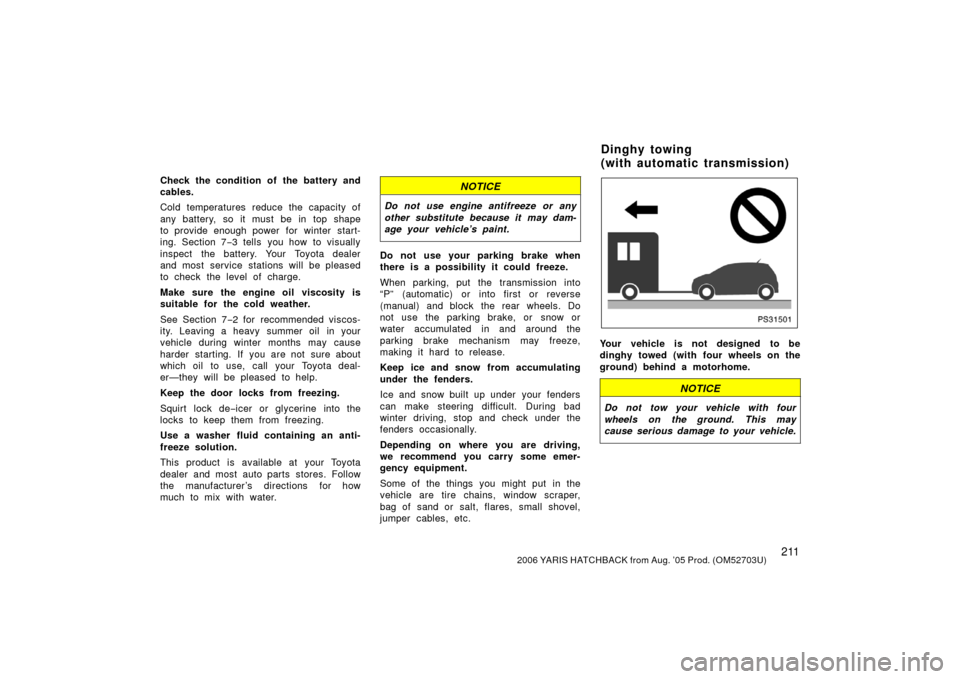Page 205 of 312

1982006 YARIS HATCHBACK from Aug. ’05 Prod. (OM52703U)
—Glossary of tire terminology
Ti r e relat ed ter mMeaning
Cold tire inflation pressure
tire inflation pressure when the vehicle has been parked for at leas t 3 hour s
or more, or it has not been driven more than 1.5 km or 1 mile under that
condition
Maximum inflation pressurethe maximum cold inflation pressure to which a tire may be inflated and it is
shown on the sidewall of the tire
Recommended inflation pressurecold tire inflation pressure recommended by a manufacturer
Accessory weight
the combined weight (in excess of those standard items which may be replaced)
of automatic transmission, power steering, power brakes, power windows, pow-
er seats, radio, and heater, to the extent that these items are available as
factory −installed equipment (whether installed or not)
Curb weight
the weight of a motor vehicle with standard equipment including the maximum
capacity of fuel, oil, and coolant, and, if so equipped, air conditioning and addi-
tional weight optional engine
Maximum loaded vehicle weight
t he sum of —
(a) curb weight;
(b) accessory weight;
(c) vehicle capacity weight; and
(d) production options weight
Normal occupant weight68 kg (150 lb.) times the number of occupants specified in the second column
of Table 1 that follows
Page 218 of 312

2112006 YARIS HATCHBACK from Aug. ’05 Prod. (OM52703U)
Check the condition of the battery and
cables.
Cold temperatures reduce the capacity of
any battery, so it must be in top shape
to provide enough power for winter start-
ing. Section 7−3 tells you how to visually
inspect the battery. Your Toyota dealer
and most service stations will be pleased
to check the level of charge.
Make sure the engine oil viscosity is
suitable for the cold weather.
See Section 7 −2 for recommended viscos-
ity. Leaving a heavy summer oil in your
vehicle during winter months may cause
harder starting. If you are not sure about
which oil to use, call your Toyota deal-
er—they will be pleased to help.
Keep the door locks from freezing.
Squirt lock de −icer or glycerine into the
locks to keep them from freezing.
Use a washer fluid containing an anti-
freeze solution.
This product is available at your Toyota
dealer and most auto parts stores. Follow
the manufacturer ’s directions for how
much to mix with water.NOTICE
Do not use engine antifreeze or any
other substitute because it may dam-
age your vehicle’s paint.
Do not use your parking brake when
there is a possibility it could freeze.
When parking, put the transmission into
“P” (automatic) or into first or reverse
(manual) and block the rear wheels. Do
not use the parking brake, or snow or
water accumulated in and around the
parking brake mechanism may freeze,
making it hard to release.
Keep ice and snow from accumulating
under the fenders.
Ice and snow built up under your fenders
can make steering difficult. During bad
winter driving, stop and check under the
fenders occasionally.
Depending on where you are driving,
we recommend you carry some emer-
gency equipment.
Some of the things you might put in the
vehicle are tire chains, window scraper,
bag of sand or salt, flares, small shovel,
jumper cables, etc.PS31501
Your vehicle is not designed to be
dinghy towed (with four wheels on the
ground) behind a motorhome.
NOTICE
Do not tow your vehicle with four
wheels on the ground. This may
cause serious damage to your vehicle.
Dinghy towing
(with automatic transmission)
Page 219 of 312

2122006 YARIS HATCHBACK from Aug. ’05 Prod. (OM52703U)
PS31502
Your vehicle can be dinghy towed (with
four wheels on the ground) from the
front behind a motorhome.
CAUTION
Dinghy towing requires special equip-
ment and accessories. Please refer to
your service outlet of the motorhome
manufacture for the recommended
equipment.
NOTICE
Dinghy towing does not eliminate the
possibility of damage to your vehicle.
DINGHY TOWING TIPS
Before dinghy towing, be sure to ob-
serve the following in order to reduce
the damage to your vehicle.1. Put the shift lever in neutral.
2. Turn the ignition switch to the “ACC” position. Make sure the audio is turned
off and any item is not plugged into
the power outlet.
NOTICE
To avoid the locking of the steering
wheel, turn the ignition switch to the
“ACC” position.
3. Release the parking brake.
After dinghy towing, let the engine idle for
more than 3 minutes before driving the
vehicle.
PS31503
NOTICE
Do not tow your vehicle from the
rear. This may cause serious damage
to your vehicle.
Dinghy towing
(with manual transmission)
Page 226 of 312

2192006 YARIS HATCHBACK from Aug. ’05 Prod. (OM52703U)
�Maintain a moderate speed on high-
ways. The faster you drive,the greater
the fuel consumption. By reducing your
speed, you will cut down on fuel con-
sumption.
�Keep the front wheels in proper
alignment. Avoid hitting the curb and
slow down on rough roads. Improper
alignment not only causes faster tire
wear but also puts an extra load on
the engine, which, in turn, wastes fuel.
�Keep the bottom of your vehicle free
from mud, etc. This not only lessens
weight but also helps prevent corro-
sion.
�Keep your vehicle tuned�up and in
top shape. A dirty air cleaner,
improper valve clearance, dirty plugs,
dirty oil and grease,brakes not
adjusted, etc. all lower engine
performance and contribute to poor fuel
economy. For longer life of all parts
and lower operating costs, keep all
maintenance work on schedule, and if
you often drive under severe
conditions, see that your vehicle
receives more frequent maintenance.
(For scheduled maintenance
information, please refer to the
“Scheduled Maintenance Guide” or
“Owner ’s Manual Supplement”.)
CAUTION
Never turn off the engine to coast
down hills. Your power steering and
brake booster will not function with-
out the engine running. Also, the
emission control system operates
properly only when the engine is run-
ning.
Page 308 of 312

3012006 YARIS HATCHBACK from Aug. ’05 Prod. (OM52703U)
PS81504
Instrument panel
20. ACC2 7.5 A: Shift lock system
21. TAIL 10 A: Side marker lights, parking
lights, tail lights, license plate lights,
multiport fuel injection system/sequen-
tial multiport fuel injection system
22. PANEL1 7.5 A: Illuminations, instru-
ment panel light control, meter and
gauge
23. A/C 7.5 A: Rear window defogger, air
conditioning system
24. D DOOR 20 A: No circuit
25. RL DOOR 20 A: Rear passenger ’s
power window (left side)
PS81505
Engine compartment
26. RR DOOR 20 A: Rear passenger ’s
power window (right side)
27. CIG 15 A: Power outlet
28. ACC 7.5 A: Door lock system, outside
rear view mirrors, audio system
29. ID/UP/MIR HTR 10 A: Multiport fuel
injection system/sequential multiport
fuel injection system
30. IGN 7.5 A: Multiport fuel injection sys-
tem/sequential multiport fuel injection
system, engine immobilizer system,
SRS airbag system, front passenger
occupant classification system 31. MET 7.5 A:
Meter and gauge
32. WIP 25 A: Windshield wiper
33. RR WIP 15 A: Rear wiper
34. WSH 15 A: Windshield wiper and rear
wiper
35. ECU�IG 10 A: Daytime running light
system, anti −lock brake system, elec-
tric power steering system, power win-
dows, door lock system, theft deterrent
system, electric cooling fan
36. GAUGE 10 A: Charging system, turn
signal lights, emergency flashers,
buck −up lights, instrument panel light
control, shift lock system, rear window
defogger, air conditioning system, auto-
matic transmission system
37. OBD2 7.5 A: On−board diagnosis sys-
tem
38. STOP 10 A: Stop lights, high mounted
stop light, multiport fuel injection sys-
tem/sequential multiport fuel injection
system, shift lock system, anti −lock
brake system
39. D/L 25 A: Door lock system
40. FR FOG 15 A: Front fog lights
41. AM1 25 A: Multiport fuel injection sys-
tem/sequential multiport fuel injection
system
Page 309 of 312
3022006 YARIS HATCHBACK from Aug. ’05 Prod. (OM52703U)
Fuses (type B)
42. HTR SUB2 40 A: Air conditioning sys-
tem
43. EPS 50 A: Electric power steering sys-
tem
44. ABS1/VSC1 50 A: Anti−lock brake sys-
tem
45. HTR 40 A: Air conditioning system
46. RDI 30 A: Electric cooling fan
47. HTR SUB1 30 A: Air conditioning sys-
tem
48. H�LP CLN/PWR HTR 30 A: No circuit
49. AMT 50 A: No circuit
50. DEF 30 A: Rear window defogger
51. PWR 30 A: Power windows
Fuses (type C)
52. ALT 120 A: Charging system, “HTR
SUB2”, “EPS”, “ABS1/VSC1”, “HTR”,
“ABS2/VSC2”, “HTR SUB1”, “RDI”,
“DEF”, “FR FOG”, “OBD2”, “D/L”,
“STOP” and “AM1” fuses
53. MAIN 60 A: “EFI”, “HORN”, “AM2”,
“ALT −S”, “DOME”, “ST”, “ECU −B”,
“ETCS”, “HAZ”, “H −LP LH/H −LP LO
LH” and “H −LP RH/H −LP LO RH” fuses